Do you wonder, ‘Will Starlink work in wooded areas?’ If yes, you have stumbled upon the perfect page.
Endeavoring to deliver high-speed internet in remote areas globally, Starlink has emerged as a promising provider of internet access.
It offers high-speed satellite internet service in unserved areas of the world through a vast constellation of satellites in low Earth orbit.
With its rising popularity, people are keen to know how Starlink will work in areas with dense trees where internet access is limited.
This article will discuss what you can expect from Starlink in wooded locations and the challenges Starlink faces in these environments.
It will also offer solutions to maximize your chances of a successful connection.
So, without further delay, let’s begin.
Can You Get Starlink In The Woods?
Before you learn “Will Starlink Work In Wooded Areas?” you need to know if you can get it in the wooded area or not.
Well, the answer is yes, you can get the Starlink in the woods.
However, it depends on the density of the trees because Starlink relies on a clear view of the sky to communicate with the satellites.
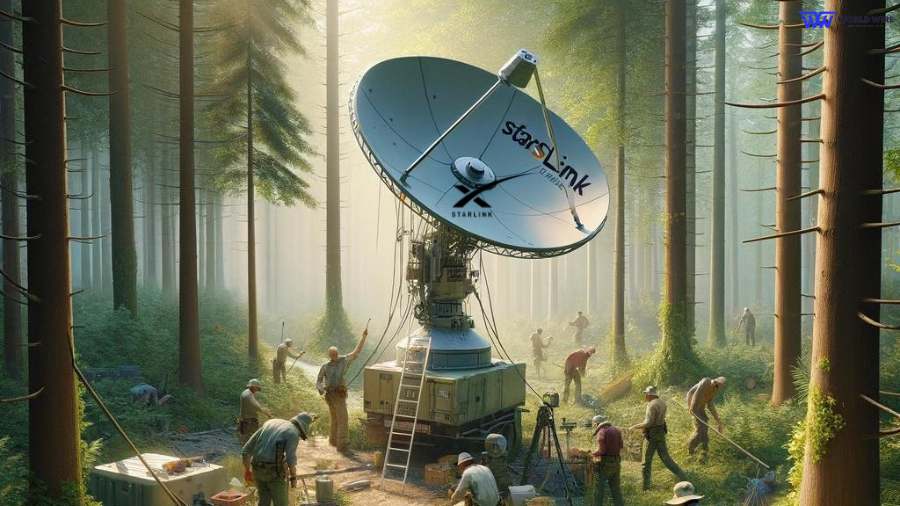
Dense forests will cause signal disruptions, affecting the internet speed and making it frustrating for activities like gaming or causing Starlink Buffering during video streams.
If you have some trees, and there is a good portion of open sky, Starlink can function well. In such cases, you can expect occasional outages when the dish passes behind a tree.
How Starlink Antenna Communicates with Satellites
It is important to learn how Starlink antennas communicate with satellites before we delve into “Will Starlink Work In Wooded Areas?”
The Starlink user terminal (commonly called the dish) communicates with Starlink satellites using phased array antennas.
The dish uses multiple antenna elements working together electronically to steer a focused beam of radio waves toward the appropriate satellite.
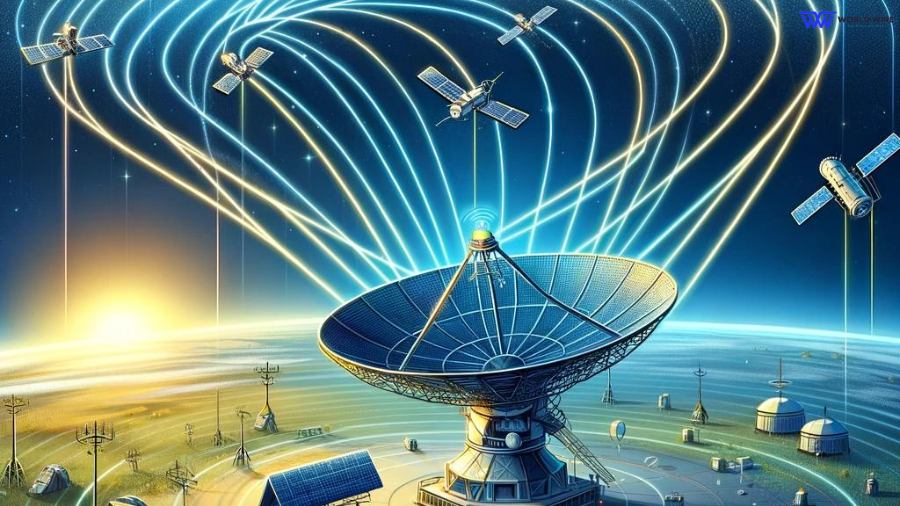
This technology, called beamforming, allows the antenna to transmit and receive signals as the satellites move across the sky.
Starlink satellites operate much closer to Earth in Low-Earth Orbit (LEO).
Here is the summary of Starlink’s communication process with satellites.
- The user terminal or dish establishes contact with passing Starlink satellites.
- The phased array antenna on the user terminal uses beamforming to target the strongest signal from a suitable satellite.
- Data is transmitted and received between the user terminal and the satellite using radio waves.
- The Starlink satellite communicates with ground stations or other Starlink satellites using Inter-satellite communication (ISL) to route the data to the internet.
This is how Starlink delivers high-speed internet access to users in various remote locations.
The important thing to note is that in the overall communication process, the dish requires a clear view of the sky with no obstructions to establish a connection with the satellites.
The optimum clearance should be at least 100 degrees around the dish and above it to allow the dish to get the best coverage.
If there are obstructions like big buildings or dense trees in the way of dish signals, you will receive interrupted internet.
Trees especially can be a big obstruction because they have water content, which obstructs radio wave transmission from satellites.
Will Starlink Work In Wooded Areas?
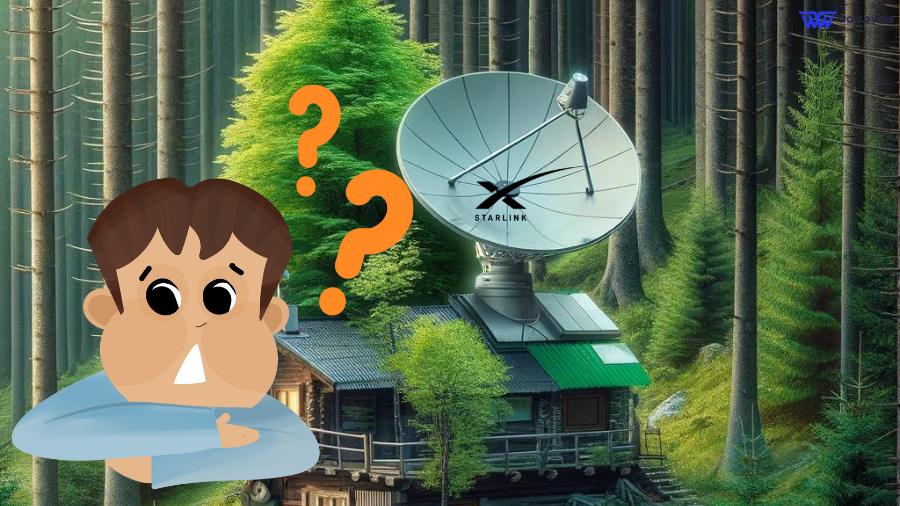
After you are informed that trees are an obstruction in the way of Starlink satellite communication, the question arises, ‘Will Starlink work in wooded areas?’
As mentioned, Starlink works in wooded areas. However, its effectiveness depends on the density and height of the trees. Why and how?
Again, as previously said, Starlink needs a clear view of the sky for its dish to communicate with satellites. Dense trees blocking the dish’s field of view can cause Starlink signal obstructions.
However, if there is light tree cover or branches, it can cause a Starlink Connection Issue or reduced speeds.
The Starlink app has a tool to help assess location suitability by determining obstructions in its dish’s way.
If you live in a wooded area, you can use its app to check if there are any obstructions at your location. This can help you decide if Starlink is a viable option for your wooded area.
Challenges Of Using Starlink In Wooded Areas
Although Starkink works in wooded areas, it has to come across several challenges from those big trees around.
Disrupted Signals
Starlink depends on a clear view of the sky to communicate with its constellation of satellites in low Earth orbit.
Trees in wooded areas can block the signal between the Starlink dish and the satellites, leading to receiving disrupted signals and delivering decreased internet speeds.
Even small branches in the way can cause issues.
Limited Placement Options
The Starlink dish needs a wide, unobstructed view of the sky. Finding a suitable location for the dish can be difficult in dense woods.
As such, locating an ideal place for the placement of Starlink dishes is a significant challenge in wooded areas.
Weather Impact
Wind and rain can move branches, causing intermittent signal disruptions.
Maintenance Needs
Regular trimming of trees may be necessary to maintain a clear signal path.
Nonetheless, you can improve reception by Starlink dishes in wooded areas by following some useful techniques. Please read about it in the subsequent sections.
Solutions For Starlink Home Users In Wooded Areas

Home users in wooded areas can use the following solutions to improve Starlink dish reception.
Finding the Best Location
Home users can use the Starlink app to find the best location for Starlink dishes, which helps determine obstructions in chosen locations.
You can also mount Starlink directly on top of the tree; our guide on Starlink Tree Mount Installation outlines the steps.
Use Trial and Error
Home users can also use trial and error to determine which locations deliver good internet. They can temporarily set up the dish in different locations to see where it gets the clearest view and which location has the best outcome.
Trimming Trees
Home users can prefer trimming low-hanging branches or small trees. However, they should follow proper safety procedures and avoid cutting down large trees or those near power lines.
Raising the Dish
Users can mount the dish on another stand, such as a roof, tower, chimney, or other such structure, to get a clearer sky view above the treeline in wooded areas.
Install it Away From the House
Users can look for a space within their house compound to install the Starlink dish a little away from the house where it can have a clear sky that is free from trees as obstructions.
Last but not least, you can contact Starlink customer service, which can help you find better locations in your area.
Alternatively, if obstructions are too severe, consider internet providers like fixed wireless or satellite internet from other providers.
Solutions For Starlink RV Users In Wooded Areas
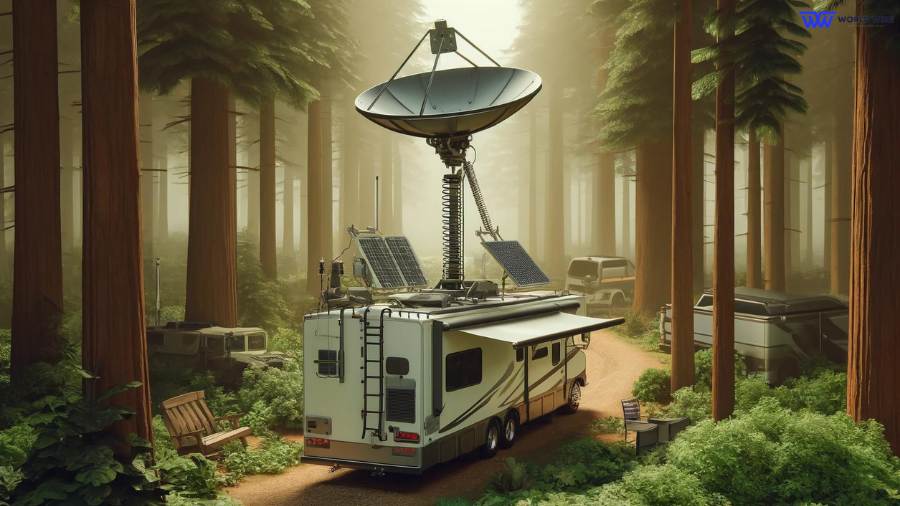
All the solutions provided above can work well for home users, but for campers, we need to consider a different approach as they need Starlink dish reception for a temporary period.
Here are some solutions for Starlink RV users to get better Starlink reception.
Moving RV
If possible, RV users can try to relocate their RV to a spot with a clearer view of the sky. This includes moving to a different location within the campground or finding a more open area.
Use a Starlink App
Campers can use the Starlink app to find areas with minimal sky obstructions and position the dish for optimal reception.
Increase Dish Height
RV users can try raising the Starlink dish on a mount or temporary stand, such as the Starlink Telescoping Pole Installation for RV, to help the dish receive clear skies without obstructions like tree branches.
They should ensure the stand is secure and would not get disturbed in windy conditions.
Trim Branches
As a last resort, RV users can carefully trim some branches that are directly blocking the dish’s view. However, they should be mindful while doing so and avoid cutting down any trees entirely.
Frequently Asked Questions
What is the best way to install Starlink in a forested environment?
Starlink can work in a wooded area as long as the antenna has a clear view of the sky. For this, the dish needs to be mounted high enough to avoid obstructions.
Installing Starlink in a forested environment can be difficult because trees can block the signal.
In such a case, you can use the Starlink app to check for obstructions before you mount the dish.
The best way is to mount your dish on an existing structure. If you have a roof, tower, chimney, shed, or barn, this could be a good option.
You need to ensure no trees block the view from that location. If no suitable structures exist, consider using a mounting pole to elevate the dish above the treeline.
Is professional installation required for Starlink in heavily wooded areas?
Starlink is designed for self-installation, but you might need a professional Starlink installation service in order to ensure the best performance from Starlink in heavily wooded areas.
They can help assess your location and find the best placement for the dish to avoid obstructions.
While professional installation is not mandatory, as you can set up the system yourself, it can be highly beneficial in heavily wooded areas to ensure you get a good signal.
What should I do if my Starlink service is frequently interrupted in a wooded area?
When your Starlink dish has a clear view of the sky, you can normally fix your Starlink interrupted service by power cycling the Starlink router 3 times in a row.
But this might not be the solution for frequent interrupted service in a wooded area, where trees can definitely challenge Starlink reception.
If your service is frequently interrupted, you can check the Starlink app for obstructions and learn which direction the blockage is coming from.
If possible, try to reposition your dish to a location where it gets a clearer view of the sky.
You need to mount it higher, maybe on your roof or a tower, to place it above the treeline.
If you have tall trees, and if it is really necessary, you can trim some branches that are in the way and causing obstructions.
Can weather conditions affect Starlink’s service in wooded areas?
Yes, weather conditions can affect Starlink’s service in wooded areas. Extreme weather, like heavy rain or snowfall, can block the signal between the satellites and the dish.
Due to this, you can get slow internet speed. Other extremities, like strong winds, can cause the Starlink dish to move, which can again interrupt the signal.
This might be more common in wooded areas where there is less structural support.
Does tree foliage affect Starlink’s internet connectivity?
Yes, tree foliage can affect Starlink’s internet connectivity. However, unlike solid objects like buildings, leaves do not completely block the signal, but they can weaken it.
The thicker and denser the tree cover, the more you will have obstructions that affect signal quality.
Dense foliage can cause significant interruptions in the signal because it disrupts the clear view between the satellite and the dish.
Conclusion
In conclusion to “Will Starlink Work In Wooded Areas,” a dish getting a clear view of the sky without obstructions is an essential condition for Starlink to deliver high-speed internet.
Starlink will work satisfactorily in wooded areas as long as the dish has a clear sky view and can establish a connection with the satellites orbiting the Earth.
Since it is difficult to get a clear sky in wooded areas, Starlink will definitely be interrupted by the surrounding trees blocking the signal’s path.
However, the intensity of interruption will depend on the density of trees.
Users can use the Starlink app to check obstructions and mount their dishes at an ideal place.
The methods mentioned in this post can help people in wooded areas get the best internet delivery from Starlink.





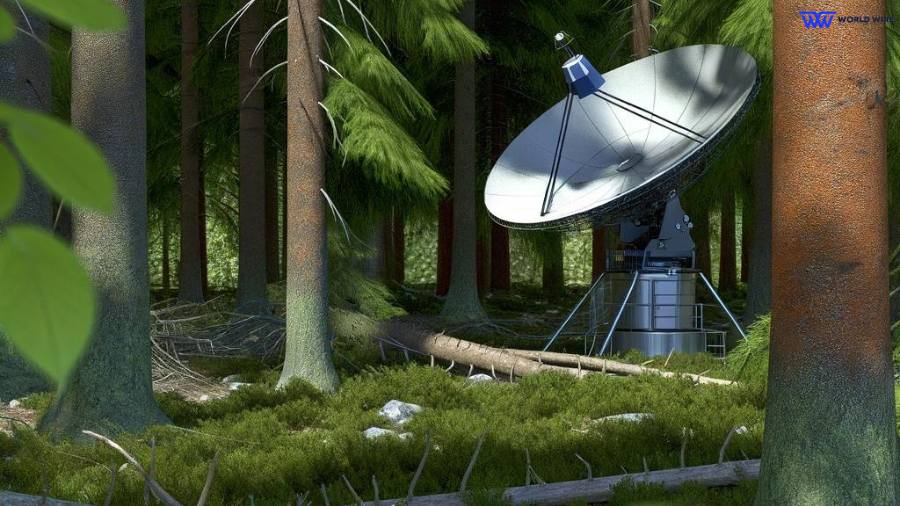

Add Comment